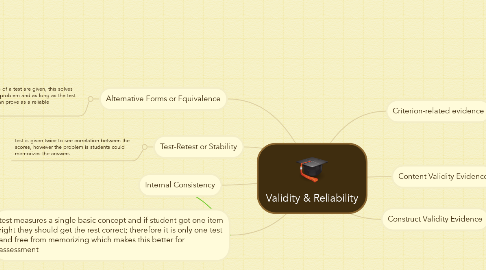Validity & Reliability
by Jenifer Steele


1. test measures a single basic concept and if student got one item right they should get the rest correct; therefore it is only one test and free from memorizing which makes this better for assessment
1.1. split-half method
1.1.1. split the test into 2 halves, however problem with this is that easy questions tend to be in the beginning of the test and difficult ones at the end
1.2. odd-even reliability
1.2.1. taking the odd questions and putting that in one test and the even questions in another test
2. Test-Retest or Stability
2.1. test is given twice to see correlation between the scores, however the problem is students could memorizes the answers
3. Internal Consistency
4. Alternative Forms or Equivalence
4.1. 2 equivalent forms of a test are given, this solves the memorization problem and as long as the test are quality tests can prove as a reliable assessment
5. Criterion-related evidence
5.1. concurrent
5.1.1. new test in relation to established test
5.2. predictive
5.2.1. the test predicts how well the student will do in the future, if it is a quality test this will help with assessment to know how future tests should be administered

